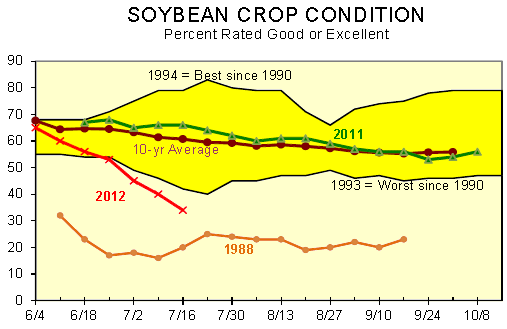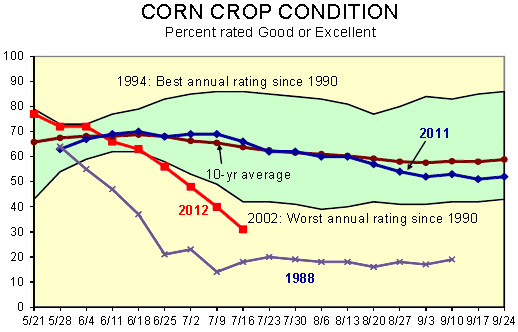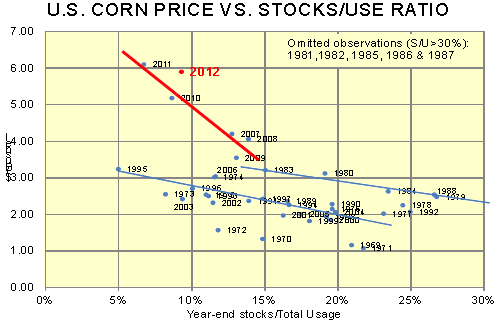



CME: Corn and Soybean Situation Equally Bad
US - In spite of generally cooler temperatures, it was another brutal week for US crops with the probability of significantly short harvests becoming more and more likely, write Steve Meyer and Len Steiner.USDA’s
weekly Crop Condition report contained little, if any, good news for
grain and oilseed users as condition ratings continue to approach
the all-time lows seen in 1988, the last widespread drought to high
major US growing areas.
Only 34 per cent of US soybean acres were rated in Good
or Excellent condition as of Sunday. That figure is 6 per cent lower
than last week and a fully 30 per cent lower than one year ago. It is
also 31 per cent lower than the 10-year average for week 28 which,
this year, ended on 15 July. The Good-Excellent per centage is still
14 per cent higher than it was at a similar point in the 1988 growing
season when hot, dry conditions pushed the Good/Excellent per centages
as low as 19 per cent in mid-August and never allowed a
figure over 23 per cent from 1 August onward.

The situation for corn is equally bad. Good/Excellent ratings for corn fell to 31 per cent this week, down 9 per cent rom last week’s 40 per cent. This week’s number compares to 55 per cent one year ago and a 10-year average of 63.8 per cent for this week. The Good/Excellent per centage for the week in 1988 was 18 per cent. 38 per cent of all corn acres are now rated as being in Poor or Very Poor condition. That compares to only 10 per cent last year at this time.

About the only piece of good news that we could find
was for spring wheat where 65 per cent remained in Good or
Excellent condition. That figure is only 1 per cent lower than last week
but is 8 per cent below last year’s 73 per cent Good/Excellent ratings
at this time.
Is the corn market overheated based on the most recent
information? That is a bit of a trick question. If one is going
only on the most recent data from USDA, we think the answer is
yes. The kicker of course is that the market may not be trading the
most recent information from USDA—-even just one week after it
was released.
We offer the chart below as evidence that the
latter is very likely the case. USDA’s estimates for production and
usage last week projected that 1.183 billion bushels would remain
in bins at the end of the 2012-13 crop year. That is sharply lower
than the June estimate but 31 per cent larger than the current forecast
for ending stocks this year. It also represents 9.3 per cent of total
corn usage for ‘12-’13. That compares to only 7.2 per cent now forecast
for ’11-’12 and 8.6 per cent for ‘10-’11. As can be seen in the chart, a
9.3 per cent year-end stocks-to-use ratio should, according to recent corn
supply-price relationships, drive an average farm price of about
$5.20/bushel, not the nearly $8 prices we are seeing now. Did corn
demand grow that much? We don’t think so. What we do believe
is that the market is trading a MUCH lower yield than the USDA’s
prediction. In fact, it appears that the trade is now looking at a yield
less than 140 bu./acre and a year-end stocks-to-use ratio of around
5 per cent — the level believed by many to be the minimum possible.









